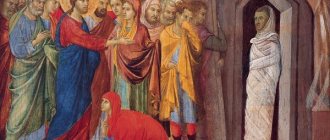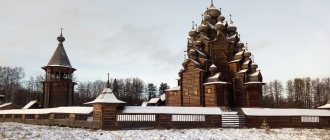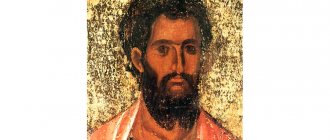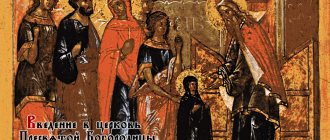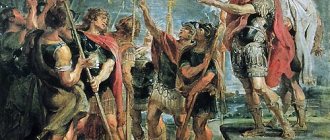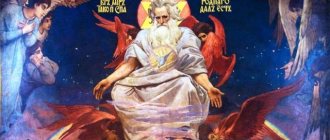CHRIST ON A DONKLE
In the earthly life of the Lord Jesus Christ there was no more solemn moment than this entrance into the holy city, when thousands of people who came to Jerusalem for the holiday of the Jewish Passover suddenly learned that the One about whom the prophet had announced was coming here: “Rejoice with joy, daughter of Zion.” , rejoice, daughter of Jerusalem: behold, your King is coming to you, righteous and saving, meek, sitting on a donkey and on the colt of a donkey, the son of the yoke" (Zech. 9:9). This triumph saw the fulfillment of the Old Testament prophecy: “The scepter will not depart from Judah, nor the lawgiver from between his feet, until the Reconciler comes, and to Him the submission of the nations. He binds his donkey's colt to the vine, and the son of his donkey to the best vine; washes his clothes in wine and his garments in the blood of grapes” (Gen. 49: 10-11).
Rice. 1. Entry of the Lord into Jerusalem. X century Ivory. Museum of Byzantine Art, Berlin
The Gospel tells that before entering Jerusalem, the Savior sent two of His disciples to fetch a donkey. The apostles Luke and Mark speak only about the colt, and Matthew also about the donkey: “The disciples went and did as Jesus commanded them: they brought a donkey and a colt and put their clothes on them, and He sat on top of them ” (Matthew 21 , 7). There is no contradiction between the apostles, for when the colt was led away, its mother followed it. Jesus “ sat on top of them ,” that is, not on two animals, but on clothes, or first He sat on a donkey, and then on a colt.
How can we explain that Jesus chose a donkey as his means of transportation? Having walked all of Galilee and Judea, during the transition from Bethany to Jerusalem (about three kilometers), the Lord, without a doubt, did not need a yoke. There is a special meaning here.
In addition to the fulfillment of prophecy, this means that He will subdue a new, unrefined and unbridled people of the Gentiles. As we know from the Gospel, the colt was tied and had owners; but those sent, that is, the “apostles,” are untied. They bring a donkey from a certain “village” so that we know that the pagan people were in great simplicity and ignorance. This people never submitted to either the Mosaic teaching or the prophetic teaching; they were “untrained colts.” Saint Epiphanius of Cyprus, in his homily on Vai Sunday, interprets this passage as follows: “Why did Christ, having previously walked on foot, now and only now sit on an animal? In order to show that He will ascend to the Cross and be glorified on it. What does the opposite signify? The obstinate disposition of the spirit of a man expelled from paradise, to whom Christ sent two disciples, that is, two Testaments, Old and New. Who does donkey mean? Without a doubt, a synagogue, which under a heavy burden carried life and on the back of which Christ will one day sit. Who does the foal mean? An unbridled pagan people, upon whom no one sat, that is, neither law, nor fear, nor Angel, nor Prophet, nor Scripture, but only one God the Word.”
The Lord, entering on a donkey, also wanted to show the people meeting him that He was making His entry with a desire for peace, not war (in the East, entering a city on a donkey is a symbol of peace, riding on a horse is a symbol of war, a conqueror).
There is a curious detail in the image of the colt carrying the Savior: its hind hooves seem to be hovering in the air against the background of the clothes of the Apostles. The Lord does not just descend from the mountain, He descends from Heaven, and this graphic implausibility tells us about the meeting of God and man.
"Procession on a Donkey"
In the XVI–XVII centuries. in Rus' in Moscow, Veliky Novgorod and other large cities there was a custom to perform a religious procession on the day of the holiday in a special way. In Moscow, a solemn procession of the cross went from the Assumption Cathedral of the Kremlin to the Cathedral of the Intercession on the Moat (St. Basil's Cathedral), one of the chapels of which was consecrated in the name of the Lord's entry into Jerusalem. The Patriarch rode on a young donkey, which was led by the king. Most often, the “donkey” was symbolic - a horse of a light color.
The western aisle of St. Basil's Cathedral (Pokrovsky Cathedral on Red Square) was consecrated in the name of the Lord's entry into Jerusalem
In Rus', this custom did not arise independently, but was borrowed from the Greeks. In the Church of Constantinople, the “procession on a donkey” was known back in the 9th–10th centuries. The earliest Russian evidence of such a custom is in the expense books of the St. Sophia Cathedral of Veliky Novgorod for 1548. The Novgorod governor drove a donkey on which the archbishop sat. The procession went from St. Sophia Cathedral to the Church of the Entrance to Jerusalem and back. It is known that such a ceremony was also held in the 17th century in Rostov the Great, Ryazan, Kazan, Astrakhan and Tobolsk. At the end of the 17th century, the custom was abolished.
Celebrating Palm Sunday on Red Square. Engraving from the book by A. Olearius “Description of a Journey to Muscovy...”. Mid-1630s - first half of the 1640s.
MOUNTAIN
“And when He approached the descent from the Mount of Olives, the whole multitude of the disciples began to praise God loudly with joy for all the miracles that they saw” (Luke 19:37). An indispensable attribute of the landscape of the icon is the image of the Mount of Olives. Typically, a mountain landscape in an icon serves as a background to highlight the central image. This roller coaster wall brings the main action to the forefront. With their color, lines and shifts, the slides also influence the aesthetic perception of the image. In the early and middle Byzantine periods, hills were depicted, as a rule, in the form of rather monolithic, dense formations, massive in color and shape. (Fig. 2).
Rice. 2. Entry of the Lord into Jerusalem. Sinai, second half. XII century
But already in the XIV-XV centuries. increased attention to the development of slides - they become concave, with split tops, ledges, crevices, etc. These visual elements in Rus' even acquired a special iconographic name - leschadki (from the ancient Russian word “leschad” - hewn stone tiles). These are a kind of stylized steps, thanks to which the mountain takes on the meaning of a ladder and is a symbol of spiritual ascent to God.
Sometimes a cave is depicted in the mountain, symbolizing the future Holy Sepulcher (Fig. 3).
Rice. 3
JERUSALEM
The placement of a mountain on the left side of the scene always corresponds to an image of a city on the right. The mountain, as a symbol of spiritual ascent, is contrasted with Jerusalem - as Jesus said before, sitting against the walls of the city: “Do you see these great buildings? all this will be destroyed, so that there will not be left one stone upon another” (Mark 13:2).
When, during the nationwide glorification and joyful greetings, Christ approached Jerusalem, then at the sight of the city, His Divine face expressed deep sorrow and He began to cry. The approaching desolation of Jerusalem and the rejection of the God-killing people were clearly visible to His eyes. The Lord knew that the actual day of visitation could be the glory and happiness of Israel, but this day would become the beginning of terrible disasters for them. He knew that the solemn “Hosanna” (meaning “salvation”, it was used as expressing joy on solemn occasions; “Hosanna in the highest” means the desire that the cries of joy be heard in heaven) in a few days would be replaced by furious cries: “ take, take, crucify Him!” (John 19:15). He already foresaw the fulfillment of God's terrible judgment over the rejected city and people. And foreseeing all this, Christ turned away - he mourned Jerusalem, which did not accept Him as the Son of God: “ Jerusalem, Jerusalem, who kills the prophets and stones those sent to you! how many times have I wanted to gather your children together, like a bird gathering its chicks under its wings, and you did not want to! Behold, your house is left empty. I tell you that you will not see Me until the time comes when you say, “Blessed is He who comes in the name of the Lord!” " (Matthew 23:37).
The architecture of Jerusalem in the icon is represented by many bizarre and closely spaced buildings behind a wall with towers. The Temple of Jerusalem is usually depicted in the center. In Russian icon painting of the 16th-17th centuries, a centric domed building topped with a cross is depicted in the center of Jerusalem. A peculiar feature of this icon is also the image outside the walls of Jerusalem of a high pillar topped with a ciborium (an altar canopy over the throne), under which are placed golden statues of pagan gods.
Rice. 4. Entry of the Lord into Jerusalem. Kirillo-Belozersky Museum-Reserve, XV century.
The main meaning of architectural “scenes” is the same as that of a mountain “landscape” - to actively participate in the creation of a holistic, dynamic image.
Description of the icon “The Entry of the Lord into Jerusalem”
In the center of the icon is Jesus, sitting sideways on a white donkey. Slightly bowing his head, He blesses with His right hand the children spreading their clothes on the ground along His path. On the left of the icon are the apostles following the Savior. There is anxiety on their faces, they are arguing about something, apparently they are alarmed and even frightened by such violent worship.
On the right side is a crowd of Jerusalem residents in festive clothes who greet the Savior with palm branches, and behind them are city walls and buildings of bright colors, which further emphasizes the holiday atmosphere.
The question has always arisen among non-believers: if Jesus was so wildly greeted upon entering Jerusalem, then how could the same crowd just a few days later demand from the procurator Pontius Pilate: “Crucify him!”
This can apparently be explained this way: the Jews were expecting the Messiah - an earthly king who would deliver their people from the power of Rome. Jesus saw His mission in a completely different way: to reveal not only to his compatriots, but also to all the peoples of the world the Truth of God and to become an atoning sacrifice for them.
The Savior always preached about the Kingdom of Heaven, and not about the earthly kingdom, and certainly did not intend to become the king of the Jews. When the people realized that they had been deceived in their hopes, they betrayed the Savior to a painful death.
BABIES
Many Byzantine-Russian icons of this holiday feature children, although the original Gospels say nothing about this. The Apostle Matthew mentions the shouting of children; but, as can be seen from the course of his speech, this happened in the temple, and not outside the city: “When the chief priests and scribes saw the wonders that He performed, and the children shouting in the temple and saying: Hosanna to the Son of David! - they were indignant” (Matthew 21:15). About children breaking branches from trees and laying them on the road, it is said in the apocrypha - the so-called. "The Gospel of Nicodemus". It tells that Pilate's messenger, sent to Christ to bring Him to trial, treated Him with complete respect, and when Pilate asked him why he did so, he replied that he saw Him sitting on a donkey and the Jewish children , breaking branches from trees and spreading them on the road; ... others spread their clothes on the way, exclaiming: Hosanna in the highest, blessed is he who comes in the name of the Lord.
Probably, under the influence of this source, the iconography of the holiday included images of rejoicing children. The white color of their clothes is, without a doubt, symbolic and signifies the purity of children's souls. In shirts of the same cut, the souls of the righteous in Abraham’s bosom are represented (by the way, as children) (Fig. 5). Such a natural arrangement of babies around the figure of Christ constitutes, as it were, an environment of heavenly angels around the King of Glory.
Rice. 5
In the XIV century. an option appears depicting genre scenes: “Children taking out a splinter” (one of the boys sits with his leg bent at the knee, and the other helps him pull the splinter out of his foot) and “Children on a tree” (Fig. 6). These stories imply that the palm tree is rough and inconvenient to climb, as it has thorns on its branches. So, the one who strives for knowledge of the Son and the Word of God must ascend to the very heights - only there, having reached the height of knowledge, can one be illuminated with the bright light of knowledge of God and the revelation of ineffable mysteries.
Rice. 6. Entry of the Lord into Jerusalem. Veliky Novgorod, XV century.
Palm Sunday in folk traditions
Some folk rituals and customs were dedicated to Palm Sunday. During Matins, the peasants prayed with blessed willow and, upon coming home, swallowed willow buds in order to protect themselves from illness and drive away any illness. On the same day, women baked nuts from dough and gave them to all household members, including animals, for health. The consecrated willow was preserved until the first pasture of livestock (April 23), and every pious housewife drove the cattle out of the yard with the willow, and then the willow itself was either “put into the water” or stuck under the roof of the house. This was done with the aim that the cattle would not only be preserved intact, but also return home in good order, and would not wander in the forest for several days.
Russian historian and ethnographer of the second half of the 19th century M. Zabylin in the book “Russian People. Its customs, rituals, legends, superstitions and poetry” describes the traditions of Palm Week.
“Palm week, or Vai week, is enlivened for us purely by the holiday of the beginning of spring; a willow or willow, which has not yet given leaves, blooms and thus, as it were, declares that our northern nature will soon reward us and everything living on earth with new blessings. The holiday itself, the Resurrection of Lazarus, serves as a symbol of the renewal and revitalization of powerful nature. During Palm Week, children's bazaars have been established in the capitals, where they sell mainly children's toys, willows, flowers and sweets, as if to commemorate the fact that small children have met the spring of their lives and should rejoice in this life, and looking at the toy, study the essence of it. of his future, since each toy is a visual literacy, a visual teaching that develops further understanding in the child, bringing him closer to life and developing his thinking through visualization, comparison of actions and images. On Lazarus Saturday, everyone is allowed to eat caviar, Lenten pancakes and various kitchen cookies.
On Palm Sunday, returning from church with blessed willow twigs, the village women whip their children with them, saying: “Whip the willow, beat them to tears!” In Nerekhta, peasant women bake lambs on Palm Sunday, and when they come from church, they feed the cattle with these lambs, and stick willows in the village at St. icons and take care of it all year round until St. George's Day. This custom is preserved in many provinces. It is known that in our country the first spring pasture of livestock begins on St. George's Day. On this day, the peasants take a one-year-old willow, soak it in holy water, sprinkle it on the cattle in the yard, and then whip the cattle with this willow, saying: “Lord, bless and reward with health!” And sometimes they simply say: “Bless you, Lord, and be healthy”... and with a willow in their hands they take you to a place of pasture. The consecrated willow is highly respected and is usually preserved by the Russian pious people behind images for a whole year. In some provinces, willow, blessed on Palm Sunday, is used as a sympathetic remedy and placed in the swill of sick cows or calves.”
TREE
The approaching Passover is the spring of the Lord, and the late greenery is the adherence to the law by which the people of Israel served God. But the Lord does not want sacrifice, but mercy. And the only thing that His people can give to God on this holiday is only a few children’s hearts, in their purity capable of seeing God Himself in the traveler descending from the mountain on a donkey. Children, who climbed the tree in the simplicity of their joy, show the depth of Love that will elevate the Son of Man to the tree of the cross.
In the symbolism of the event of the Entry of the Lord into Jerusalem and its liturgical celebration, palm branches and fronds occupy an important place. Among the ancient Jews, the palm tree - a beautiful, branched and fruitful tree - served as a symbol of fun and celebration: “on the first day take for yourself branches of beautiful trees, branches of palm trees and branches of broad-leaved trees and river willows, and rejoice before the Lord your God seven days” (Lev. 23, 40). It was customary to greet noble people with palm trees in their hands. The palm tree is a symbol of courage and was given as a reward to the winners.
The branches of the tree also mean the Cross, with which the Lord trampled death and gave life to believers. Therefore, on Vaiy Sunday the Church proclaims: “Today the grace of the Holy Spirit has gathered us together, and we have all taken up Your cross, saying: Blessed is he who comes in the name of the Lord, Hosanna in the highest.”
According to the Church, green branches serve as a sign of victory over death not only of Jesus Christ, but with Him and those who believe in Him. In winter, the branches of the trees seem to be dead, but with the onset of spring they come to life again. All people die, and death comes for them - this harsh winter, but spring will come and the bodies that have decayed in the earth will again unite with the soul. This is God’s law: He will clothe corruptible things with incorruptibility and make dead things immortal (1 Cor. 15:53).
Palm Sunday. history of the holiday
The Feast of the Entry of the Lord into Jerusalem has been known since the first centuries of Christianity. Already in the 3rd century, Saint Methodius of Patara mentioned him in his teaching. The Holy Fathers Ambrose of Milan and Epiphanius of Cyprus, who lived in the 4th century, in their sermons say that the holiday is celebrated solemnly, many believers walk on this day in a solemn procession with branches in their hands. Therefore, the holiday received another name - Vaii or Flower Week. In Rus', just at this time, fluffy earrings bloom. Hence the popular name of the holiday - Palm Sunday . On this day, food with fish is allowed. The day before, on Lazarus Saturday, it is customary to eat caviar.
